MOVE: A story of government-sanctioned murder?
By Michael Z. Muhammad -Contributing Writer- | Last updated: May 22, 2017 - 5:31:17 PMWhat's your opinion on this article?
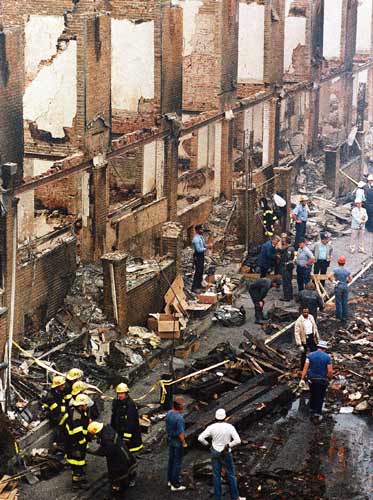
Photo: In this May 15, 1985 file photo, people sort through debris on Osage Avenue in Philadelphia, after a blaze destroyed scores of homes in the area. The fire started when police dropped a bomb onto the house of the of the group MOVE, and it spread throughout the area. Photo: AP/Wideworld Photos
|
Their crime? Housing citations.
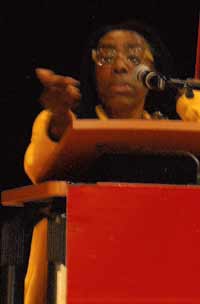
Ramona Africa
|
The group says no one was criminally charged in what was tantamount to government sanctioned murder.
The radical right to life group presented its narrative during a symposium titled “ONA MOVE! A Conference presented by the Move Organization,” held May 5-7 at the Universal Audenreid Charter High School.
Organizers said the purpose of the conference was to clarify misconceptions about the organization and allow the community to “hear about MOVE from MOVE.”
Attendees came from as far away as France, Belgium, and Germany.
What emerged from the conference was MOVE defining itself is an organization that has solutions to societal ills. As such it poses a threat to the “system,” said MOVE members. They say founder John Africa was a true revolutionary who faced brutal, deadly push back of the American system that ultimately cost him his life.
The conference included a series of panel discussions that provided information about the organization from inception through the bombing and the controversial federal trial of John Africa. Panelists included MOVE members, community supporters and neighbors who were present during their ordeal.
Sue Africa, a Caucasian member, was sent to a mental hospital as a result of her involvement in MOVE. A White woman following a Black man, John Africa, must have been insane, she said.
During the early 1970s, MOVE was characterized by dreadlocks and an uncompromising commitment to their beliefs and their teacher.
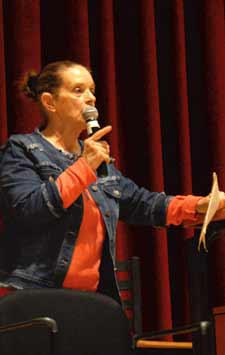
Sue Africa
|
From the beginning, MOVE was in conflict with the system and police, observed speakers. MOVE was about life, and this system is about slavery, suffering, and death, some argued.
One of the major criticisms of MOVE was the organization’s use of profanity. Sue Africa deflected this criticism saying, “If our profanity offends you realize the need for the descriptive language. See how destructive society is in profaning itself. The betrayal and suffering of the masses by a corrupt government that is the real obscenity.”
She went on to say MOVE was purposefully distorted and presented as “nasty, dirty and profane.”
Group members described teachings of John Africa as ahead of its time. MOVE exposed injustice, oppression and disrespect for life, they said. The group used strategies of profanity and nonviolent protest in demonstrations at the Philadelphia Zoo, Board of Education, political rallies and public forums, they added.
Reverence for life drove MOVE to create rescue missions for stray animals, aid homeless people, assist the elderly and intervene in violence between local gangs, said MOVE members.
Mike Africa talked about the value the organization placed on personal discipline and physical fitness. MOVE also had a strong belief in family and protecting family that drew the wrath of the system, said MOVE members.
Prominent MOVE member Ramona Africa said, “You have to understand the context to understand what MOVE was up against.”
“During the 1970s the mayor of Philadelphia was Frank Rizzo. He was the former racist police commissioner, and the police department was his reflection. In the Black community, the police were resented and feared,” she said.
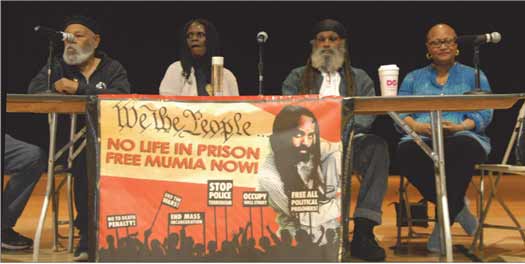
(L-R) Mo Africa, Cansuewella Africa, Abdul Jon and Barbara Grant.
|
“As MOVE began speaking out against the police department, the police started to harass us,” Ramona Africa continued. “They would break up our peaceful demonstrations by arresting MOVE members on trumped up charges.”
A violent encounter between police and two pregnant female MOVE members, who were walking to a store, resulted in miscarriages in 1974, Ramona Africa said. “In 1976, ten police cars came to MOVE headquarters in response to a noise complaint. Janine Africa with her three month- old baby was thrown to the ground and stomped resulting in the death of her child. Police claimed the incident never happened and no one was ever held “accountable or charged,” she continued.
“At this point, MOVE stopped protesting against social issues and focused squarely on police misconduct resulting in organization members unfair incarceration,” she said. “The fact that something is legal doesn’t make it right. Slavery was legal. Killing Native Americans and stealing their land was all done legally.”
MOVE defined means what it says, Pam Africa said. Move, work, generate, be active. Everything alive has motion. Movement is the principle of life, and because MOVE’s belief is life, John Africa gave us the name MOVE, she said.
Janine Africa called into the conference from prison. “I will never leave MOVE. It stands for family, security, and strength. As a family, we are one force and no man can split one. You can’t fake strength. The power of truth is real in me,” she said.
Consuewella Africa told the story of the blockade of the MOVE headquarters in 1978. The goal was to starve MOVE members out of their home. It lasted two months at the cost of thousands of dollars a day in police overtime. It led to the August 1978 police assault on MOVE headquarters which resulted in the brutal beating of Delbert Africa and the death of police officer James Ramp. Nine MOVE members received sentences from 30 to 100 years. These are today known as the MOVE 9.
Lynn Washington, a noted journalist who extensively covered the organization, said over 250,000 gallons of water poured into the MOVE home during the confrontation. He characterized police behavior as “unfathomable lawlessness. MOVE members are in jail today because of their beliefs.”
The final confrontation took place on May 13, 1985, resulting in the bombing on Osage Avenue. That day two bombs dropped on the home igniting a fire that destroyed blocks of homes and cost millions in damage. Wilson Goode, a Black man, was mayor at the time. What is not known is that as managing director he promised to remedy the continued injustice. To understand the enormity of what transpired that day Ramona Africa stated there was a deeper narrative. “The police didn’t intend for there to be any survivors. They brought a full scale military assault on MOVE using tear gas, shot guns, M-60 machine guns, 20mm anti-tank gun and 50 caliber machine gun.” The incident took the lives of six adults and five children. Ramona Africa and Birdy Africa, a child, were the only survivors.
The conference ended with a potent description of the federal trial of John Africa in 1981. “The coordinator and I were arrested for bomb making and weapons charges,” said Carlos Africa who was a co-defendant.
He described how federal prosecutors presented a mountain of evidence. John Africa slept through much of the trial, made no rebuttal, but delivered an impassioned closing argument.
Mike Africa read a portion of John Africa’s closing argument that condemned the system and exposed the courts “as tools of the industry that profits from poisoning the air, water, and food necessary for all life.” The government was left in shock when the jury delivered a not guilty verdict on all charges, he said.
Dr. Suzanne Ross, a long time supporter, provided an update to the conference on Mumia Abu Jamal, both his current medical and legal struggles. Mr. Jamal, a talented freelance journalist, was one of the few people who accurately reported on MOVE. He extensively covered the 1978 confrontation and resulting trials. In 1981 he was charged with the murder of a Philadelphia police officer. He requested to be represented by John Africa. He was subsequently sentenced to death after being charged with 1st degree murder. Currently the charge has been reduced to life.
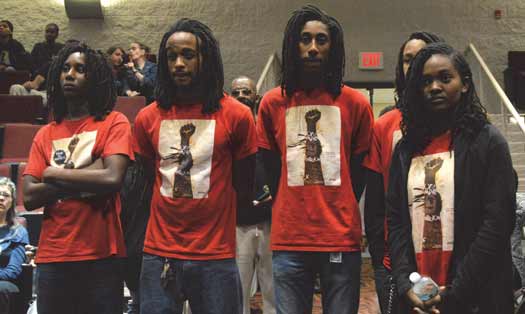
MOVE youth group LIFE. Photos: Michael Z. Muhammad
|
Mr. Abu-Jamal was diagnosed with Hepatitis-C. Dr. Ross went into detail regarding the legal battle that ensued to get him medically treated. He won and is now receiving needed treatment. “In a major break, Pennsylvania Common Court of Appeals Judge Leon Tucker ordered the release of a trove of documents relating to the unconstitutional involvement of former Pennsylvania District Attorney and Pennsylvania Supreme Court Chief Justice Ronald Castille in the trial of Mumia Abu-Jamal. This discovery order represents a significant development in the struggle to restore Mumia’s appellate rights and, eventually, to overturn his wrongful conviction in the 1981 shooting of a Philadelphia police officer,” Dr. Tucker related.
Fred Hampton, Jr., son of Black Panther Fred Hampton, Sr., attended the conference, coming from Chicago. He came to acknowledge May 13, 1985 as a day of “brutal acts of terrorism.”
“The Black Panther Cubs are present in solidarity for the freedom of the MOVE 9, Mumia Abu-Jamal and all political prisoners,” he said.
“It is important to preserve the history and to hear from people that were there,” writer Lynn Washington told The Final Call. “Most of the written commentary about MOVE is written from the outside in. So this type of conference is important to set the historical record straight. One of the things I noticed in my coverage of MOVE is the systemic lawlessness that has been undergirding all of this. When you look at it, MOVE is attacked by police, but MOVE is charged. What made MOVE different was while the entire Black community suffered under police brutality, they fought back,” he said. MOVE believed in the right to self-defense and used weapons to defend themselves against police aggression, said some panelists.
Walt Palmer, an activist, scholar who acted as mediator in many of the MOVE disputes with the city, was also a conference panelist. In an interview with The Final Call, he said, “MOVE is a prototype for the miscarriage of justice in American society especially applying it to people of color. Nine people (MOVE 9) went to prison for a crime they did not commit.”
“MOVE’s legacy will be their tenacious persistence. The organization’s ability to keep on pushing and redefining what freedom is,” Mr. Palmer said.
INSIDE STORIES AND REVIEWS
-
-
About Harriett ... and the Negro Hollywood Road Show
By Rabiah Muhammad, Guest Columnist » Full Story -
Skepticism greets Jay-Z, NFL talk of inspiring change
By Bryan 18X Crawford and Richard B. Muhammad The Final Call Newspaper @TheFinalCall » Full Story -
The painful problem of Black girls and suicide
By Charlene Muhammad -National Correspondent- » Full Story -
Exploitation of Innocence - Report: Perceptions, policies hurting Black girls
By Charlene Muhammad -National Correspondent- » Full Story -
Big Ballin: Big ideas fuel a father’s Big Baller Brand and brash business sense
By Bryan Crawford -Contributing Writer- » Full Story






 Click Here Stay Connected!
Click Here Stay Connected!








